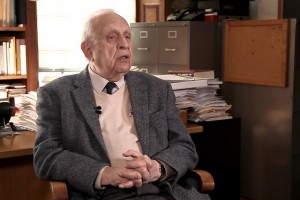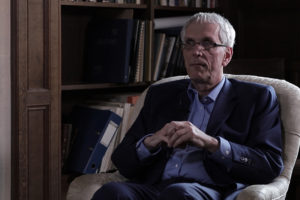Microrobotics
Computer Scientist Sergej Fatikow on the variety of microrobots, possibilities for their application, and curr...

In the 19th century, invisible radiation capable of passing through flesh and other materials seemed utterly unbelievable. Now, X-rays are widely used for creating medical images, conducting radiation therapy, analyzing works of art, and solving problems in atomic energy. Together with physicist Alexander Dolgov, we explored how X-ray radiation was discovered and how it helps people.
Since the end of the 19th century, science has begun to play a fundamentally new role in shaping the worldview. Just a century ago, the activities of scientists were amateur and private. However, by the end of the 18th century, science had become a systematic activity of many specialists due to the scientific and technological revolutions. Research institutes began to emerge, periodic scientific journals appeared, and competition and struggle for recognition of authorship rights arose. All these processes also took place in the German Empire, where by the end of the 19th century, the Kaiser encouraged scientific achievements that enhanced the country’s prestige.
One of the scientists who worked passionately during this period was Professor of Physics and Rector of the University of Würzburg, Wilhelm Conrad Röntgen. On November 8, 1895, he stayed late in the laboratory, as often happened, and decided to conduct experimental research on electrical discharge in glass vacuum tubes. He darkened the room and wrapped one of the tubes in opaque black paper to make observing the optical phenomena accompanying the discharge easier. To his surprise, Röntgen saw a fluorescence strip on the nearby screen, covered with crystals of barium platinocyanide.
The scientist hardly could have imagined then that he was on the threshold of one of the most important scientific discoveries of his time. Over a thousand publications were written about X-rays the following year, and medics immediately adopted the invention. This later led to the discovery of radioactivity and new scientific disciplines.
Röntgen dedicated the following weeks to investigating the nature of the mysterious glow and established that fluorescence appeared every time he applied current to the tube. The radiation source was the tube rather than any other electrical circuit part. Not knowing what he had encountered, Röntgen decided to refer to this phenomenon as X-rays.

Röntgen later discovered that this radiation could penetrate almost all objects to varying depths, depending on the object’s thickness and the material’s density. For example, a small lead disk between the discharge tube and the screen proved impenetrable to X-rays, while the bones of the hand cast a darker shadow on the screen, surrounded by a lighter shadow from soft tissues. Soon, Röntgen discovered that X-rays caused the screen covered with barium platinocyanide to fluoresce and darkened photographic plates (after development) in areas where X-rays hit the photographic emulsion.
Röntgen confirmed that he discovered radiation previously unknown to science during his experiments. On December 28, 1895, he reported the results of his research in the article titled “On a New Kind of Radiation” in the journal “Annals of Physics and Chemistry.” At the same time, he sent famous photographs of his wife Anna Bertha Ludwig’s hand to scientists. Thanks to Röntgen’s old friend, Austrian physicist Franz Exner, these photos were first seen by the residents of Vienna on January 5, 1896, in the newspaper Die Presse. The next day, news of the discovery reached the London Chronicle. Thus, Röntgen’s discovery gradually began to enter people’s everyday lives. On January 20, 1896, in New Hampshire, doctors assisted a person with a broken arm for the first time with a new diagnostic method — an X-ray.

In several years, X-rays began to be actively used to conduct more precise operations. Just 14 days after the discovery, Friedrich Otto Walkhoff made the first dental X-ray. Later, with Fritz Giesel, he founded the world’s first dental radiology laboratory.
By 1900, just five years after its discovery, the use of X-rays in diagnostics was considered an integral part of medical practice. The statistics collected by the oldest hospital in Pennsylvania are a significant indicator of the dissemination of X-ray radiation technologies. According to the study, in 1900, only about 1–2% of patients received assistance using X-rays. By 1925, this number had risen to 25%.
At that time, X-rays were often used in unusual ways. For example, to remove hair. People considered this method to be less painful than tweezing or waxing. Also, X-ray radiation was used in pedoscopes —devices for fitting shoes. These were X-ray machines with a special recess for the feet and windows through which the customer and the salespeople could assess how the shoes fit.

X-ray radiation is a form of electromagnetic radiation with photon energies ranging from approximately 100 electron volts (eV) to 250 kilo-electron volts (keV). It falls on the electromagnetic spectrum between ultraviolet radiation and gamma radiation. This type of radiation is a component of natural radiation, which occurs in radioisotopes when atoms of elements are excited by streams of electrons, alpha particles, or gamma rays, resulting in the ejection of electrons from the atomic electron shells. X-ray radiation is produced when charged particles accelerate, particularly when electrons decelerate in the electric field of atoms in atoms.
X-rays can be classified into soft and hard radiation, with a conventional boundary on the wavelength scale at approximately 0.2 nm, corresponding to a photon energy of around 6 keV. Due to their short wavelength, X-rays are both penetrating and ionizing, as they interact with electrons when passing through matter, knocking them out of atoms. This interaction breaks the atoms into ions and electrons, altering the material’s structure.
X-ray radiation causes the luminescence of chemical compounds, known as fluorescence. When atoms in a sample are irradiated with high-energy photons, electrons are emitted and leave the atom. This creates “holes” or vacancies in one or more electron orbitals, causing the atoms to enter an excited and unstable state. Within millionths of a second, the atoms return to a stable state as vacancies in the inner orbitals are filled by electrons from the outer orbitals. This transition is accompanied by energy emission in the form of secondary photons, which is the fluorescence source.
We rarely encounter X-ray radiation on Earth, but it is commonly found in space. It naturally arises due to the activity of many cosmic objects, enabling the field of X-ray astronomy. The energy of X-ray photons is much greater than that of optical photons, so matter emitting in the X-ray range is heated to extremely high temperatures. Sources of X-ray radiation include black holes, neutron stars, and quasars. X-ray astronomy has made it possible to distinguish black holes from neutron stars, discover the Fermi bubbles, and capture the process of destroying a normal star as it approaches a black hole.

These cosmic X-ray radiation sources do not constitute a noticeable part of the natural radiation background and pose no threat to humans. The only potential exception would be a source of hard electromagnetic radiation, such as a supernova explosion occurring sufficiently close to the Solar System.
X-ray machines are still widely used for non-destructive introspection (X-ray imaging in medicine, defectoscopy in engineering). Their main component is the X-ray tube, which consists of a cathode and an anode. The tube electrodes are connected to a high-voltage source, usually several tens or hundreds of thousands of volts. When heated, the cathode emits electrons, which are accelerated by the electric field between the cathode and the anode. As the electrons collide with the anode, they decelerate and lose most of their energy. This produces bremsstrahlung (braking radiation) in the X-ray range. However, most of the electrons’ energy is converted into heat, so the anode must be cooled.

The continuous or pulsed X-ray tube remains the most common X-ray radiation source, but it is not the only one. High-intensity radiation pulses are generated using high-current discharges, where the plasma channel of the current is compressed by its magnetic field—a process known as pinching. If the discharge occurs in a medium of light elements, such as hydrogen, it acts as an effective electron accelerator due to the electric field generated within the discharge. This field can significantly exceed the one created by an external current source. This method produces pulses of hard X-ray radiation with high-energy photons (hundreds of kilo electronvolts) with high penetrating power.
Electron accelerators, such as synchrotrons, produce X-ray radiation across a broad spectral range. In synchrotrons, radiation is generated inside a ring-shaped vacuum chamber, where a tightly focused beam of high-energy electrons moves along a circular orbit, accelerated to nearly the speed of light. As the electrons turn under the influence of a magnetic field, they emit photon beams tangentially to the orbit. These beams span a wide spectrum, with a peak in the X-ray range.
For a long time, a thin layer of phosphor or photographic emulsion applied to the surface of a glass plate or transparent polymer film was used to detect and measure X-rays. When exposed to X-rays, the phosphor emits visible light, while the film undergoes a chemical reaction, changing the optical transparency of its coating.
Nowadays, electronic detectors are most commonly used to register X-ray radiation. These devices produce an electrical pulse when a radiation quantum is absorbed within the detector’s sensitive volume. They differ in how they convert the absorbed radiation energy into electrical signals. X-ray detectors with electronic registration can be divided into ionization detectors, which operate based on the ionization of matter, and radioluminescent detectors, including scintillation detectors, which use the luminescence of matter under ionizing radiation. Depending on the detecting medium, ionization detectors are further classified into gas-filled and semiconductor detectors.
The main types of gas-filled detectors are ionization chambers, Geiger counters (Geiger-Müller counters), and proportional gas discharge counters. Radiation quanta entering the detector’s working medium cause gas ionization and the flow of current, which is then registered. In a semiconductor detector, electron-hole pairs are formed under the influence of radiation quanta, allowing an electric current to flow through the detector body.
A secondary electron multiplier is an open vacuum device (operates only in vacuum conditions) where incoming X-ray radiation is converted into a stream of primary electrons and amplified through secondary electron emission as they propagate through the multiplier channel. Microchannel plates work on the same principle. These plates consist of many individual microscopic channels that penetrate the plate detector. They can also provide spatial resolution and form an optical image of the cross-section of the X-ray beam hitting the detector by bombarding a phosphor-coated semi-transparent screen with the outgoing electron stream.
A relatively new field that is currently developing in microbiology and medicine is the use of soft X-ray radiation. When penetrating a living organism, it allows for imaging blood vessels, detailed examination of the structure of soft tissues, and even conducting microbiological research at the cellular level. An X-ray microscope that uses radiation from a pinch discharge in heavy element plasma enables the observation of details in the structure of living cells that even an electron microscope cannot see, even in specially prepared cellular structures.
One type of radiation therapy used to treat malignant tumors utilizes hard X-ray radiation. This is possible due to its ionizing effect, which destroys the tissue of the biological target. In this case, an electron accelerator is used as the radiation source.
The ability to penetrate materials makes possible X-ray imaging. This visualization method allows for displaying the internal structure of opaque objects, such as those made of metal. It is impossible to visually determine whether the welds on a bridge are secure, if the seam of a gas pipeline is airtight, or if the rails fit closely together. Therefore, in the industry, X-ray imaging is used for defectoscopy, which inspects the reliability of an object’s primary working properties and parameters or its individual elements without taking the object out of operation or dismantling it.
X-ray fluorescence spectrometry is based on the fluorescence effect. It is used to determine the concentrations of elements from beryllium to uranium in various substances from 0.0001% to 100%. When a sample is irradiated with a powerful beam from an X-ray tube, the atoms emit characteristic fluorescent radiation proportional to their concentration in the sample. Nowadays, almost every electron microscope can determine the detailed elemental composition of micro-objects being studied using the method of X-ray fluorescence analysis without any difficulties.
Important developments in this field include new methods specialized for working with artworks. The macroscopic fluorescence method is a variant of X-ray fluorescence analysis well-suited for visualizing the distribution structure of key elements, mainly metals, over areas of approximately 0.5–1 square meters or more. On the other hand, X-ray laminography, a variant of computed X-ray tomography, is promising for obtaining images of individual layers of a painting and is more suitable for studying flat surfaces. These methods can also be used to analyze the chemical composition of the paint layers, which allows for dating the canvas and detecting forgeries.
X-ray crystallography is a scientific field focused on determining the structure of matter at the atomic and molecular levels. A distinctive feature of crystalline substances is the repeated orderly arrangement of identical elements (cells) in their spatial structure, consisting of a specific set of atoms, molecules, or ions.

The primary research method involves directing a narrow beam of X-rays at a crystalline sample using an X-ray camera. The resulting photograph displays the pattern of diffracted X-rays passing through the crystal, allowing scientists to visually map its spatial structure, known as the crystal lattice. The various techniques for conducting this method are called X-ray crystallography.

Computer Scientist Sergej Fatikow on the variety of microrobots, possibilities for their application, and curr...

Physicist Roy Glauber on light, quantum coherence, and development of the laser

Chemist David Clary on quantum tunnelling, the rates of chemical reactions and how Schrödinger's equation help...